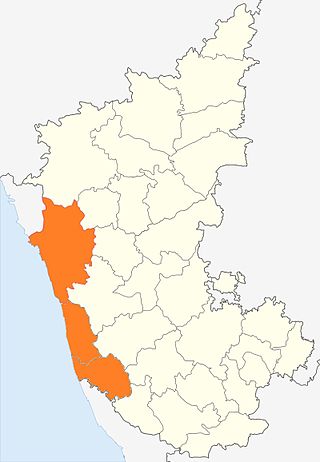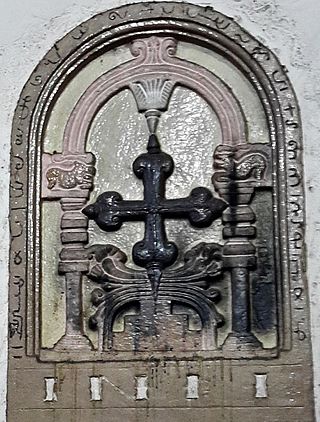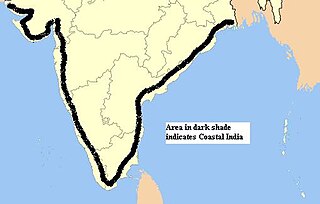Coastal South West India is a geo-cultural region in the Indian Subcontinent that spans the western half of Coastal India. [1] The region was referred as Sapta Konkan region in the Skanda Purana. [1]
Contents

Coastal South West India is a geo-cultural region in the Indian Subcontinent that spans the western half of Coastal India. [1] The region was referred as Sapta Konkan region in the Skanda Purana. [1]

Coastal South West India spans across the entire Arabian Sea coastline of the Indian subcontinent from the coastline of the Gulf of Kutch in its westernmost corner and stretches across the Gulf of Khambhat, and through the Salsette Island and Mumbai along the Konkan and southwards across the Raigad region and through Kanara and further down through Mangaluru (Mangalore) and along the Malabar unto the southernmost tip to Kanyakumari (Cape Comorin). In ancient tradition Coastal South West Indian Subcontinent extends till Sri Lanka. [1]
The people along coastal south west India exhibit vast diversity along an underlying commonality as a result of long history of contact with west Asian Mediterranean traders along the Arabian sea coastline.
The region includes Gujaratis in the westernmost region, Maharashtrians and Goans along the western coastline, Kannadigas in its south western coastline and Tuluvas and Malayalis in its southernmost region of South India.

As a result of the thriving trade between the Mediterranean world and South West Indian coastline along the Arabian sea, [2] [3] [4] [5] there has been significant intermingling between the people of Coastal South West India and the west asian world. Several west Asian communities have also settled and become part of the diversity of coastal south west India. These include the Parsis, [6] Bohras [7] and Baghdadi Jews [8] in the westernmost region, the Bene Israel along the South western region the descendants of mediterranean traders along Coorg and Mangalore, the Jonakan Mappilas [9] along Malabar region, and the cochin jews [2] [3] [4] [9] [10] [11] [12] and Syriac Nasranis [2] [3] [4] [9] [10] [11] [12] along the southernmost region of South India.
The linguistic diversity of the Coastal south west India includes Languages of the Dravidian language family including Malayalam, Tulu, and Kannada; languages belonging to the western zone of Indo Iranian language families including Gujarati, Marathi, Konkani and languages belonging to the central zone of the Indo-Iranian language families including Urdu and Persian. The region also has speakers of Semitic languages like Arabic, Hebrew and Aramaic. The common elements of the people of coastal south west India includes cuisine that consists of agrarian and coastal products and clothing that involves long flowing drapes with bare midriff for both men and women suited for humid and warm climate. [13] Throughout the region women wear drapes called saree in various styles. [13] In the western corner of the region the drapes are called as Dhoti for men. [13] and Chaniya choli for women, [13] further southwards the drapes are called as lungi or mundu for men. [13] and veshti for women. [13] Another common cultural element of coastal south west India includes relatively more role for women in social system. [13] Towards the southernmost tip of coastal south western India the social system is considerably more matri-focal with instances of matrilineal and matriarchal tradition like amongst the Bunt community of Tulus and the Marumakkathayam of the nairs and a section of Mappila Muslims. [14] This is also manifested in feminine deity oriented festivals and rituals celebrating Shakti or feminine power [15] like Navratri festival among the Gujarati People and Thiruvathira festival among the Malayali people.

Cochin Jews are the oldest group of Jews in India, with roots that are claimed to date back to the time of King Solomon. The Cochin Jews settled in the Kingdom of Cochin in South India, now part of the present-day state of Kerala. As early as the 12th century, mention is made of the Jews in southern India by Benjamin of Tudela.
South Indian culture refers to the cultural region typically covering the South Indian states of Tamil Nadu, Karnataka, Kerala, Andhra Pradesh, and Telangana. The idea of South India is closely linked to the Dravidian ethnic and linguistic identity and therefore it can also refer to groups in central India such as the Gondi and the Kui. Similar to India it is difficult to define a common essence of South Indian culture. That being some common threads include the eternal universe through the celebration of the beauty of the body and femininity. It is exemplified through its dance, clothing, and sculptures.

Kanara or Canara, also known as Karavali is the historically significant stretch of land situated by the southwestern coast of India, alongside the Arabian Sea in the present-day Indian state of Karnataka. The subregion comprises three civil districts, namely: Uttara Kannada, Udupi, and Dakshina Kannada. Kassergode was included prior to the States Reorganisation Act.
The Malayali people are a Dravidian ethnolinguistic group originating from the present-day state of Kerala in India, occupying its southwestern Malabar coast. They form the majority of the population in Kerala and Lakshadweep. They are predominantly native speakers of the Malayalam language, one of the six classical languages of India. The state of Kerala was created in 1956 through the States Reorganisation Act. Prior to that, since the 1800s existed the Kingdom of Cochin, the Kingdom of Travancore, Malabar District, and South Canara of the British India. The Malabar District was annexed by the British through the Third Mysore War (1790–92) from Tipu Sultan. Before that, the Malabar District was under various kingdoms including the Zamorins of Calicut, Kingdom of Tanur, Arakkal kingdom, Kolathunadu, Valluvanad, and Palakkad Rajas.

Mappila Muslim, in general, is a member of the Muslim community of same name found predominantly in Kerala and Lakshadweep Islands, in southern India. Muslims of Kerala make up 26.56% of the population of the state (2011), and as a religious group they are the second largest group after Hindus (54.73%). Mappilas share the common language of Malayalam with the other religious communities of Kerala.
The term Kerala was first epigraphically recorded as Cheras (Keralaputra) in a 3rd-century BCE rock inscription by the Mauryan emperor Ashoka of Magadha. It was mentioned as one of four independent kingdoms in southern India during Ashoka's time, the others being the Cholas, Pandyas and Satyaputras. The Cheras transformed Kerala into an international trade centre by establishing trade relations across the Arabian Sea with all major Mediterranean and Red Sea ports as well those of Eastern Africa and the Far East. The dominion of Cheras was located in one of the key routes of the ancient Indian Ocean trade. The early Cheras collapsed after repeated attacks from the neighboring Cholas and Rashtrakutas.
South Asian ethnic groups are an ethnolinguistic grouping of the diverse populations of South Asia, including the nations of Bangladesh, Bhutan, India, Maldives, Nepal, Pakistan, and Sri Lanka. While Afghanistan is variously considered to be a part of both Central Asia and South Asia, Afghans are generally not included among South Asians.

Islam arrived in Kerala, the Malayalam-speaking region in the south-western tip of India, through Middle Eastern merchants. The Indian coast has an ancient relation with West Asia and the Middle East, even during the pre-Islamic period.

Mar Thoma Sleeva (Saint Thomas Cross) are ancient crosses associated with the community of Indian subcontinent, who trace their origins to the evangelism of Thomas the Apostle in the 1st century AD. The Saint Thomas Christians, which is one of the oldest Christian communities of the world, survive in the Malabar region in state of Kerala, India and have a diaspora in other parts of the Indian subcontinent. Saint Thomas Christian crosses are known as Mar Thoma Sleeva (Saint Thomas cross), Indian cross, or Persian Cross in English, as well as Nasrani Sthambam in Malabarese.
The term Gujarati Muslim is usually used to signify an Indian Muslim from the state of Gujarat in western coast of India. Most Gujarati Muslims have the Gujarati language as their mother tongue, but some communities have Urdu as their mother tongue. The majority of Gujarati Muslims are Sunni, with a minority of Shi'ite groups.

The population of Kerala, India is a heterogenous group that comprises many ethnic groups that originated in other parts of India as well as the world, with distinctive cultural and religious traditions. While the majority of Keralites speak the Malayalam language, various ethnic groups may speak other languages as well.

North Malabar refers to the geographic area of southwest India covering the state of Kerala's present day Kasaragod, Kannur, and Wayanad districts, and the taluks of Vatakara and Koyilandy in the Kozhikode District of Kerala and the entire Mahé Sub-Division of the Union Territory of Puducherry. Traditionally North Malabar has been defined as the northern portion of the erstwhile Malabar District which lies between Chandragiri River and Korapuzha River. The region between Netravathi River and Chandragiri River, which included the portions between Mangalore and Kasaragod, are also often included in the term North Malabar, as the Kumbla dynasty in the southernmost region of Tulu Nadu, had a mixed lineage of Malayali Nairs and Tuluva Brahmins.

Sephardic Jews in India are Iberian Jews who settled in many coastal towns of India, in Goa and Damaon, Madras and, primarily and for the longest period, on the Malabar coast in Cochin. After the Portuguese discovery of the sea route to India in the 1498, a number of Sephardic Jews fled Antisemitism in Iberia which had culminated in the Edict of Expulsion in 1492 and Persecution of Jews and Muslims by Manuel I of Portugal. They settled in Portuguese Indian trading places so that they could continue practicing Judaism secretly while still remaining within the Portuguese Empire. After the Portuguese Inquisition was established, an additional number of falsely-converted Sephardic Jews made sea voyages to settle in India, because it would then be difficult for the Inquisition to investigate and punish them. They spoke the vernacular language of their kingdom and some of them also Arabic.

Religion in Kerala is diverse. According to 2011 census of India figures, 54.73% of Kerala's population are Hindus, 26.56% are Muslims, 18.38% are Christians, and the remaining 0.33% follow other religions or have no religion. As of 2020, Hindus, Muslims, Christians and others account for 41.5%, 43.9%, 13.9% and 0.7% of the total child births in the state, respectively.

The Malabar Coast is the southwestern region of the Indian subcontinent. It generally refers to the western coastline of India stretching from Konkan to Kanyakumari. Geographically, it comprises one of the wettest regions of the subcontinent, which includes the Kanara region of Karnataka and all of Kerala.

Coastal India is a geo-cultural region in the Indian subcontinent that spans the entire coastline of India.(7516.6 km; Mainland: 5422.6 km, Island Territories: 2094 km)

The Saint Thomas Christian denominations are Christian denominations from Kerala, India, which traditionally trace their ultimate origins to the evangelistic activity of Thomas the Apostle in the 1st century. They are also known as "Nasranis" as well. The Syriac term "Nasrani" is still used by St. Thomas Christians in Kerala. It is part of the Eastern Christianity institution.

The following outline is provided as an overview of and topical guide to Kerala:

Kaduthuruthy Marth Mariam Knanaya Major Archiepiscopal Church, commonly called Kaduthuruthy Valiapally or the Great Church of Kaduthuruthy, is a historic church founded by the Knanaya community in 400 C.E. The Knanaya are the descendants of Syriac Judeo-Christians who migrated from Persian Mesopotamia to Kodungallur, Kerala, during the medieval era.

The Kadavumbhagham Ernakulam Synagogue in Kerala, India, is the restored oldest synagogue of the Malabar Jews with a Sefer Torah scroll and offering occasional services. It was established in 1200 CE and restored several times through the centuries on the same site. It is modeled on the earliest synagogue of the Malabar Jews at Muziris, which dated from the time of ancient sea trade between the Mediterranean and Kerala.